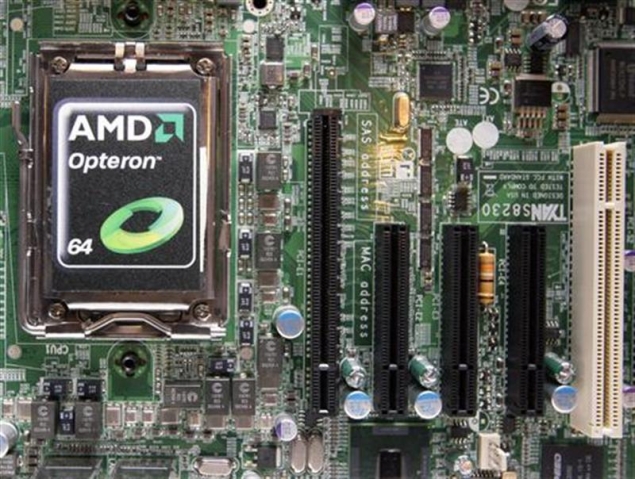- Home
- Laptops
- Laptops News
- Advanced Micro adopts smartphone technology for servers
Advanced Micro adopts smartphone technology for servers

AMD will expand its push into the still-new microserver market, combining ARM's architecture typically used in smartphones with the x86 architecture common in PCs and servers, Chief Executive Officer Rory Read said on Monday.
"AMD is the only computing company on the planet that's introducing this ambidextrous architecture spanning both x86 and ARM ecosystems," he told reporters at an event.
One of Silicon Valley's oldest chipmakers, AMD is losing money and struggling to redefine itself as consumers increasingly favor tablets over laptops and as manufacturers worried about the economy hold off on building new PCs.
The company, which is a distant No. 2 to top chipmaker Intel Corp, announced this month it would slash 15 percent of its workforce, while devoting more resources to areas outside of its traditional PC business, including communications, industrial and gaming applications.
AMD's focus on microservers is a clear albeit indirect bet on the proliferation of smartphones, tablets and other personal computing devices.
"The data center is where we fundamentally think the growth is going to be and where the innovation is going to be," said Lisa Su, AMD's senior vice president and general manager, global business units.
Battery friendly
Like Intel, Sunnyvale, California-based AMD was caught flat-footed in recent years with the emergence and fast growth of mobile devices like Apple's iPad.
Nearly all smartphones and tablets now use battery-friendly technology licensed by ARM to chipmakers like Qualcomm and Samsung Electronics.
AMD's adoption of ARM's technology comes as the British company turns toward data centers, where servers using its low-power technology are challenging the powerful Intel processors that currently power most servers. AMD also makes similar x86 server chips.
When it comes to web surfing on tablets, or analyzing activities on Facebook in real time, data centers with many small, low-power processors are more efficient than those with a few large processors, said Patrick Moorhead, the head of Moor Insights & Strategy.
"The new realm of servers is being driven by changes in client devices like smartphones and tablets," Moorhead said. "What mega-data center builders are doing now is trying to find the most optimal architecture, and what they're looking at very closely are microservers."
ARM has been working on its own 64-bit chip technology, a standard suited to data centers that takes better advantage of memory than its 32-bit chip technology used in smartphones and tablets. Intel and AMD already use 64-bit technology in their x86 server processors.
AMD executives said they will focus on 64-bit server chips using ARM technology, with products expected in 2014. They said AMD may eventually use ARM's technology for other kinds of chips as well.
AMD has previously talked about plans to follow a strategy of adding other companies' intellectual property to its future chip designs, mixing and matching different technologies to suit customers' needs.
Read, who left PC maker Lenovo last year to lead AMD, told analysts on a recent quarterly conference call that he had underestimated how quickly the PC industry was changing.
He said AMD must accelerate its shift toward designing embedded chips for fast-growing markets like game consoles and medical equipment.
"Get the business balanced, simplify the portfolio, lower the cost base, then go after embedded (chips). That's in the tactical time frame," Read told Reuters in an interview, asked about AMD's strategy for the next few months.
AMD expects its revenue to fall 10 percent in the current quarter compared with the September quarter. Reflecting the chipmaker's troubles, AMD's stock has fallen 59 percent over the past year.
AMD took a step into the microserver market in March with the acquisition of Silicon Valley startup SeaMicro for $334 million, But it is not the only company to bet on microservers.
Austin, Texas-based startup Calxeda is also focusing on ARM-based processors for data centers and Intel is working on low-powered versions of its x86 chips.
Dell and Hewlett-Packard have also said they plan to sell ARM-based servers.
With years of execution setbacks also weighing on AMD, the company is burning through cash, and industry analysts have recently become concerned about future liquidity.
AMD's cash declined $279 million in the third quarter to $1.48 billion. AMD said it was reducing its "optimal" cash target to $1.1 million from $1.5 billion due to the business' now smaller size.
© Thomson Reuters 2012
Get your daily dose of tech news, reviews, and insights, in under 80 characters on Gadgets 360 Turbo. Connect with fellow tech lovers on our Forum. Follow us on X, Facebook, WhatsApp, Threads and Google News for instant updates. Catch all the action on our YouTube channel.
Related Stories
- Samsung Galaxy Unpacked 2025
- ChatGPT
- Redmi Note 14 Pro+
- iPhone 16
- Apple Vision Pro
- Oneplus 12
- OnePlus Nord CE 3 Lite 5G
- iPhone 13
- Xiaomi 14 Pro
- Oppo Find N3
- Tecno Spark Go (2023)
- Realme V30
- Best Phones Under 25000
- Samsung Galaxy S24 Series
- Cryptocurrency
- iQoo 12
- Samsung Galaxy S24 Ultra
- Giottus
- Samsung Galaxy Z Flip 5
- Apple 'Scary Fast'
- Housefull 5
- GoPro Hero 12 Black Review
- Invincible Season 2
- JioGlass
- HD Ready TV
- Laptop Under 50000
- Smartwatch Under 10000
- Latest Mobile Phones
- Compare Phones
- Redmi Note 15 5G
- Redmi Note 15 Pro 5G
- Redmi Note 15 Pro+ 5G
- Lava Play Max
- Poco C85 5G
- Honor Magic 8 Lite
- Jolla Phone
- Realme P4x 5G
- Asus ProArt P16
- MacBook Pro 14-inch (M5, 2025)
- OnePlus Pad Go 2
- Poco Pad M1
- Just Corseca Skywatch Pro
- Honor Watch X5
- Acerpure Nitro Z Series 100-inch QLED TV
- Samsung 43 Inch LED Ultra HD (4K) Smart TV (UA43UE81AFULXL)
- Asus ROG Ally
- Nintendo Switch Lite
- Haier 1.6 Ton 5 Star Inverter Split AC (HSU19G-MZAID5BN-INV)
- Haier 1.6 Ton 5 Star Inverter Split AC (HSU19G-MZAIM5BN-INV)

















